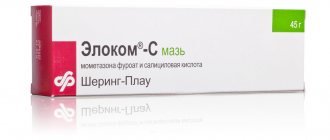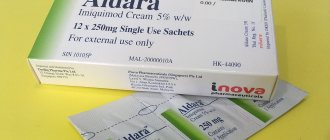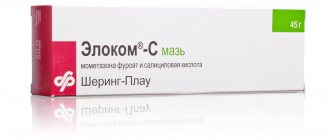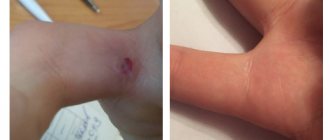Components of Terbinafine
The instructions indicate the following ingredients of the medication:
- Tablets - presented with terbinafine hydrochloride, lactose monohydrate, potato starch, talc, aerosil, magnesium stearate, MCC;
- Ointment - terbinafine hydrochloride, carbomer, vaseline oil, polysorbate, sodium hydroxide, water, propylene glycol, methyl parahydroxybenzoate.
Terbinafine is produced not only in ointments and tablets, but also in cream and spray. The choice of the appropriate form to combat fungal infection is the responsibility of the attending physician. External forms are used for mild lesions, oral forms for systemic infection.
Indications for use of Terbinafine
The main indication for prescribing Terbinafine ointment is damage to the skin by a fungal infection. First of all, these are mycoses of the skin of the foot. In addition to fungus on the legs, the remedy treats fungal infections of the groin area, which experts call tinea cruris. In addition, smooth areas of the body infected with fungus can also be treated with ointment.
Diaper rash, in the absence of timely and adequate skin care, can become a breeding ground for the proliferation of pathogenic microorganisms. Fungi of the genus Candida especially love this humid environment. This is a yeast type that quickly spreads in folds, on the crooks of the arms and fingers, as well as on hairy areas of the body (head, armpits, groin). Treatment with Terbinafine ointment makes it possible to get rid of this pathogen.
Signs of lichen versicolor are also a reason to prescribe Terbinafine. Mycosis is a common skin disease that affects not only adults, but also children. The first signs of the spread of a fungal infection are the following markers:
- Redness on the skin, usually with clearly defined boundaries of the source of infection. The borders may be uneven and irregular in shape.
- The edges of the lesion often have a whitish tint, especially for lesions of fungi of the genus Candida.
- The inflamed area is itchy.
- The surface of the skin of the affected area peels off.
- At the site of inflammation, vesicles with serous contents appear. Violation of the surface of the bubbles leads to the separation of liquid and the formation of crusts.
Fungal infections are transmitted by contact and airborne droplets. In addition, failure to comply with hygiene standards provokes the spread of mycoses. Therefore, when visiting baths, saunas, public showers and other public places with high humidity, it is necessary to avoid contact of bare feet with the floor.
Mycosis can also appear as a result of wearing low-quality shoes made from non-breathable materials. It is also not recommended to wear synthetic socks in closed shoes.
Contraindications to treatment
Terbinafine tablets are not used:
- for acute or chronic liver pathologies;
- renal failure;
- allergies to lactose, lactase deficiency;
- intolerance to the component composition;
- body weight less than 20 kg or under 3 years of age;
- breastfeeding.
Particular care is needed when carrying out therapeutic measures for people:
- with chronic renal failure, neoplasms;
- alcohol addiction;
- problems with the functionality of the hematopoietic system;
- diseases of the endocrine department;
- psoriasis, narrowing of the lumens in the blood vessels of the legs, etc.
Therapy is carried out with monitoring of the functioning of the kidneys and liver. Terbinafine is discontinued if:
- discomfort in the abdomen, jaundice;
- weakness, nausea;
- changes in the color of urine to dark, and stool to a light shade.
Local forms of the medication are not used for allergies or hypersensitivity to components.
The list of relative contraindications to the use of Terbinafine is presented:
- insufficient performance of the liver and kidneys;
- alcohol addiction;
- diseases of the endocrine department;
- tumor-like processes.
The drug is not recommended for patients under 12 years of age.
special instructions
Irregular use or early termination of treatment increases the risk of relapse. If after 2 weeks of treatment there is no improvement in the condition, it is necessary to re-determine the causative agent of the disease and its sensitivity to the drug. During the treatment process, it is necessary to follow general hygiene rules to prevent reinfection (through underwear, shoes). Avoid contact with the mucous membrane of the eyes, nose, and mouth.
Impact on the ability to drive vehicles and operate machinery
During the period of treatment with the drug, it is possible to drive vehicles and engage in other potentially hazardous activities that require increased concentration and speed of psychomotor reactions.
How to use the drug correctly
The instructions recommend taking the medication according to your doctor’s regimen. Standard dosages of Terbinafine (tablets):
- babies weighing up to 20 kg – 62.5 mg;
- 20-40 kg – 125 mg;
- more than 40 kg or adults – 250 mg.
The duration of treatment procedures depends on the current pathological process:
- dermatomycosis of the feet – 2-6 weeks;
- candidiasis of the dermis, dermatomycosis of the body, extremities – 0.5-1 month;
- lesions of the skin under the hair on the head - calendar month;
- onychomycosis – 6-12 weeks.
For pathologies of the nail plates, treatment can continue until the nail plates are completely replaced.
The instructions recommend applying the ointment up to two times a day; before using Terbinafine, the skin is first cleaned and dried. Therapy continues according to the current disease:
- pityriasis versicolor – 2 weeks;
- dermatomycosis of the skin – 7-14 days;
- foot damage – up to 1 month;
- mycosis of nails – from 3 to 6 months.
The abstract requires strict adherence to treatment deadlines. Irregular use or early cessation of manipulation may cause re-activation of the infection. If after 14 days the symptoms of the disease do not decrease, the patient needs to consult a doctor.
Terbinafine tablets
Registration number: R No. LSR-008787/10
Trade name of the drug: Terbinafine-MFF.
International nonproprietary name: Terbinafine.
Dosage form: Tablets.
Composition per tablet: Active substance:
- Terbinafine hydrochloride 281 mg (corresponding to 250 mg terbinafine base).
Excipients (to obtain a tablet weighing 0.390 g):
- Colloidal silicon dioxide – 2 mg
- Calcium stearate monohydrate (calcium stearate 1-water) – 2 mg
- Potato starch - 29 mg
- Microcrystalline cellulose (MCC-200) – 47 mg
- Lactose monohydrate – 8 mg
- Crospovidone (polyplasdone XL-10) – 8 mg
- Crospovidone (polyplasdon XL) – 8 mg
- Povidone K 90 (plasdon K-90) - 5 mg
Description: Tablets are white or almost white, with a slight specific odor, flat-cylindrical in shape with a chamfer and a score.
Pharmacotherapeutic group: Antifungal agent.
ATX code: D01BA02
Pharmacodynamics: Terbinafine belongs to the group of allylamines and has a wide spectrum of antifungal action. In low concentrations it has a fungicidal effect on dermatophytes Trichophyton spp. (T. rubrum, T. mentagrophytes, Ttonsurans, T. verrucosum, Tviolaceum), Microsporum canis, Epidermophyton floccosum, molds (for example, Scopulariopsis brevicaulis), yeasts, mainly Candida albicans. For fungi Candida spp. and their mycelial forms have a fungicidal or fungistatic effect, depending on the type of fungus. Terbinafine disrupts the early stage of biosynthesis of the main component of the fungal cell membrane (ergosterol) by inhibiting the enzyme squalene epoxidase. When administered orally, it is not effective in the treatment of pityriasis versicolor caused by Pityrosporum ovale, Pityrosporum orbiculare (Malassezia furfur).
Pharmacokinetics: When taken orally, more than 70% is well absorbed; absolute bioavailability due to the “first pass” effect is reduced by 40%. After a single oral dose of 250 mg, the time to reach maximum concentration (TCmax) is about 2 hours; maximum concentration (dmax) - 1 μg/ml. The area under the curve of the infection localization is 2 - 6 weeks; for mycoses of other parts of the body, legs or torso: 2 - 4 weeks; for mycoses caused by fungi of the genus Candida: 2 - 4 weeks; for mycoses of the scalp caused by fungi of the genus Microsporum: more than 4 weeks.
Children: With body weight from 20 to 40 kg: 125 mg 1 time per day. For body weight more than 40 kg: 250 mg once a day. The duration of treatment for mycoses of the scalp is about 4 weeks; for infection with Microsporum canis it can be longer.
Elderly patients are prescribed the drug in the same doses as adults. For patients with hepatic and renal insufficiency, terbinafine is prescribed at a dose of 125 mg once a day.
Side effect:
- Dyspeptic disorders (decreased appetite, nausea, diarrhea, feeling of fullness in the stomach, abdominal pain)
- Allergic skin reactions (urticaria, rash)
- Musculoskeletal reactions (arthralgia, myalgia), aggravation of systemic lupus erythematosus
Disorders of taste, including their loss (recovery occurs within several weeks after cessation of treatment).
Rarely (with a frequency of 0.01 - 0.1%) a hepatotoxic effect is observed (increased activity of “liver” transaminases, liver failure). Malignant exudative erythema (Stevens-Johnson syndrome), toxic epidermal necrolysis (Lyell's syndrome), psoriasis-like skin rashes, exacerbation of psoriasis, anaphylactoid reactions, agranulocytosis or thrombocytopenia, neutropenia, lymphopenia.
Overdose: Symptoms: Nausea, vomiting, headache, dizziness, pain in the lower abdomen, in the epigastric region, frequent urination.
Treatment: Gastric lavage followed by the use of activated charcoal and/or symptomatic therapy.
Interaction with other drugs: Inhibits the CYP2D6 isoenzyme and disrupts the metabolism of drugs such as tricyclic antidepressants and selective serotonin reuptake inhibitors (for example, desipramine, fluvoxamine), beta-blockers (metoprolol, propranolol), antiarrhythmics (flecainide, propafenone), inhibitors monoamine oxidase B (eg, selegiline) and antipsychotic (eg, chlorpromazine, haloperidol) agents. Drugs that induce cytochrome P450 isoenzymes (for example, rifampicin) can accelerate the metabolism and elimination of terbinafine from the body. Drugs that inhibit cytochrome P450 isoenzymes (for example, cimetidine) can slow down the metabolism and elimination of terbinafine from the body. If these drugs are used concomitantly, a dose adjustment of terbinafine may be required. Menstrual irregularities are possible when taking terbinafine and oral contraceptives simultaneously. Terbinafine reduces the clearance of caffeine by 21% and prolongs its half-life by 31%. Does not affect the clearance of phenazone, digoxin, warfarin. When used together with ethanol or drugs that have hepatoxic effects, there is a risk of developing drug-induced liver damage.
Special instructions: Irregular use of terbinafine or premature cessation of treatment may lead to relapse of the disease. The duration of therapy can be influenced by factors such as the presence of concomitant diseases, the condition of the nails with onychomycosis at the beginning of the course of treatment. If after 2 weeks of treatment of a skin infection there is no improvement in the condition, it is necessary to re-determine the causative agent of the disease and its sensitivity to the drug. Systemic use for onychomycosis is justified only in the case of total damage to most nails, the presence of severe subungual hyperkeratosis, and the ineffectiveness of previous local therapy. When treating onychomycosis, a laboratory-confirmed clinical response is usually observed several months after mycological cure and cessation of treatment, which is due to the rate of regrowth of a healthy nail. Removal of nail plates is not required when treating onychomycosis of the hands for 3 weeks and onychomycosis of the feet for 6 weeks. In the presence of liver disease, the clearance of terbinafine may be reduced. During treatment, it is necessary to monitor the activity of “liver” transaminases in the blood serum. In rare cases, cholestasis and hepatitis occur after 3 months of treatment. If signs of liver dysfunction occur (weakness, persistent nausea, decreased appetite, excessive abdominal pain, jaundice, dark urine or discolored stools), the drug should be discontinued. Prescribing terbinafine to patients with psoriasis requires caution, because in very rare cases, terbinafine can cause an exacerbation of psoriasis. When treating with terbinafine, general hygiene rules should be observed to prevent the possibility of re-infection through underwear and shoes. During treatment (after 2 weeks) and at the end it is necessary to carry out antifungal treatment of shoes, socks and stockings.
Release form: Tablets 250 mg. 10 or 14 tablets in a blister pack made of polyvinyl chloride film and aluminum foil with thermovarnish. One or two blister packs along with instructions for use are placed in a cardboard pack.
Shelf life: 2 years. Do not use after expiration date.
Storage conditions: In a dry place, protected from light, at a temperature not exceeding 25 ° C. Keep out of the reach of children.
Conditions for dispensing from pharmacies: By prescription.
Overdose symptoms
Accidental use of large quantities of Terbinafine tablets may cause:
- dermatological rash, cephalalgia;
- frequent urination;
- attacks of vomiting with dizziness;
- discomfort from the gastrointestinal tract.
Therapy includes gastric lavage with activated charcoal. In difficult cases, symptomatic treatment is prescribed.
There is no information in the annotation about cases of ointment overdose. These adverse reactions occur when an external agent is accidentally taken orally.
Pharmacokinetics and pharmacodynamics
When taking the medicine orally, the active substance is rapidly absorbed from the digestive tract. Its partial metabolism occurs in the liver, as a result, its bioavailability decreases to 40%. The bioavailability of the drug is only slightly affected by food intake, so there is no need to adjust the dose.
The highest concentration of the drug in the blood is observed 2 hours after the 250 mg tablet was taken. 99% of the active substance in the blood binds to plasma proteins.
The drug is noted to be onycho- and epidermotropic, that is, its largest amount (concentrations optimal for a therapeutic effect) accumulates in the hair, skin, nails, and also in the subcutaneous tissue.
In the body, terbinafine hydrochloride is biotransformed into metabolites that do not demonstrate antifungal activity. Most of them are excreted in the urine. The half-life is 17 hours.
There is no accumulation of Terbinafine when taken. Its effectiveness is the same for all patients, regardless of the person’s age. In the presence of pathological changes in the liver and kidneys, the biotransformation of the drug may slow down. As a result, its concentration in biological fluids increases and the period of circulation of the drug in the blood increases.
When using Terbinafine topically, no more than 5% of the active component enters the blood.
Interaction with other drugs
Combination with foreign drugs provokes:
- influence on the clearance of drugs - Cyclosporine, oral contraceptives, Tolbutamide;
- increased concentration of histamine blockers in the blood;
- slowing down the excretion of Rifampicin;
- changes in the menstrual cycle - when combined with oral contraceptives.
Drug-induced liver damage occurs when taken with hepatotoxic drugs or ethanol.
pharmachologic effect
Terbinafine has a pronounced antifungal effect. The ointment is intended for topical use. It is effective in combating dermatophytes, varieties of molds and dimorphic fungi. When applying a small amount of the product, it is possible to achieve a fungicidal effect.
In relation to yeast fungi, Terbinafine can have both fungicidal and fungistatic effects. Its activity is mainly manifested in the treatment of skin lesions by representatives of the genus Candida albicans. The ointment affects biosynthesis processes during the early stage of sterol formation, namely, a deficiency of ergosterol is formed and a simultaneous increase in squalene content. This imbalance of chemical bonds leads to the death of fungal cells. The ointment is safe in relation to the cell membrane of the human body. It does not have any effect on the production of hormones, the functioning of internal organs and the effect of other medications. No more than 5% of the drug is absorbed into the bloodstream if a dense layer is applied. The systemic effect in this case is insignificant.
Terbinafine price, where to buy
The price of Terbinafine in tablets is from 210 rubles for 10 pieces. Terbinafine Teva tablets can be bought for an average of 130 rubles. (pack of 7 pcs.). The average price of Terbinafine cream is 80 rubles. per pack 15 g. The price of Terbinafine spray is from 300 rubles. for 30 ml.
Price of Terbinafine ointment in UAH. (Ukraine) – from 100 UAH. You can purchase the product in Dnepropetrovsk and other cities by order.
- Online pharmacies in RussiaRussia
- Online pharmacies in UkraineUkraine
ZdravCity
- Terbinafine Canon tablets 250 mg 10 pcs. JSC Canonpharma Production
163 rub. order - Terbinafine tablets 250 mg 14 pcs. JSC Canonpharma Production
RUB 256 order
- Terbinafine tablets 250 mg 14 pcs. JSC Medisorb
RUB 209 order
- Terbinafine tablets 250 mg 28 pcs. JSC Medisorb
RUB 374 order
- Terbinafine-vertex tab. 250 mg 10 pcs. Vertex AO
RUB 332 order
Pharmacy Dialogue
- Terbinafine (cream 30g)Vertex
RUB 234 order
- Terbinafine (cream 15g)Vertex
119 RUR order
- Terbinafine (cream 15g) Belmedpreparaty
53 RUR order
- Terbinafine tablets 250 mg No. 10Vertex
RUB 298 order
- Terbinafine-Canon (tab. 250 mg No. 14)Canonpharma Production
RUB 243 order
show more
Pharmacy24
- Terbinafine-KV 250 mg No. 14 tablets PAT "Kiev Vitamin Plant", Kiev, Ukraine
80 UAH. order
Reviews of Terbinafine
Both reviews of Terbinafine tablets and reviews of cream and ointment appear online in most cases, positive. Patients write about the quick effect after starting to take Terbinafine and Terbinafine Teva tablets. With their help, it was possible to get rid of fungal diseases and restore the structure of the nails.
Those who have used Terbinafine ointment also leave positive reviews, noting that the product is inexpensive, but at the same time it allows you to completely cure fungal diseases and get rid of diaper rash in a few weeks. However, side effects develop very rarely.
Analogs
Level 4 ATX code matches:
Atifin
Binafin
Lamican
Griseofulvin
Analogues in tablets are the drugs Lamican , Onychon , Terbizil , Binafin , Exifin , Myconorm , Terbinafine hydrochloride , etc.
Analogues of Terbinafine for external use are the drugs Termicon , Lamisil Uno , Terbinox , Terbizil , Mikonorm , Lamitel , Terbinafine-MFF , etc.



